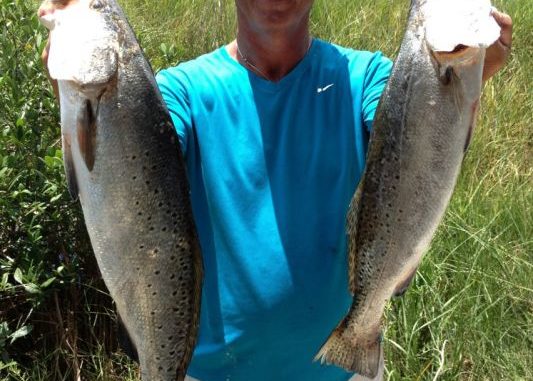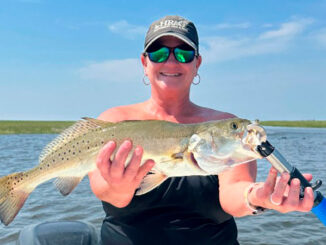
Target moving current over submerged rocks, expert angler says
The thermometer and the calendar both say fall has arrived, but Tommy “Carl” Vidrine’s ice chest looks pretty much like it did early this summer — chocked full of 4- and 5-pound Grand Isle speckled trout.
Four months ago, the 49-year-old independent contractor for Aflac was free-lining big live shrimp and consistently catching monsters.
Now, his live bait of choice is pogies, but the results are just about the same. (And as a bonus, he says mangrove snapper and ladyfish don’t tear up the pogies like they do live shrimp.)
“The pogies are going to attract only the bigger specks. The small fish usually won’t mess with it,” Vidrine said. “So if your game is going after big trout and you’ve never caught ‘em before, this is the trick.”
He likes 3- to 4-inch pogies, and uses a dark 4/0 Kahle hook on 15-pound green Trilene line, with an 1/8-ounce split shot about 3-feet from the hook.
He tries to cast at least 20 yards from his boat so the trout can’t see him, and the pogy usually stays within a foot of the water’s surface, Vidrine said.
“You’ll see the trout eat the pogy many times. He’s on top swimming trying to get off that hook, and when that pogy sees that trout looking at him, he starts vibrating real hard,” he said. “He’s swimming normal, and all of a sudden you feel a vibration at the end of your pole and he’s swimming real hard, and then you feel that strike — boom. And your line starts going sideways.”
With larger trout, you can gently set the hook immediately with the strike. But on smaller 2- to 3-pound specks, patience is key because of the size of the pogy, he said.
“The fish will hook himself. He’s not going to let that pogy go. Just hold him tight until you feel a lot of pressure where he’s almost pulling the rod out of your hand,” Vidrine said. “Then just lift and set the hook. Give it some time because that’s a lot of meat in their mouth.”
Whereas getting an early start before the heat of the day was critical in the summer, Vidrine is more concerned in the fall with finding good moving current over submerged rocks.
His favorite fall fishing spots for free-lining pogies are Caminada Pass, the Fourchon rocks, Timbalier Island and Belle Pass.
“Get a nice moving tide, either incoming or outgoing, and position yourself on different parts of the submerged rocks. Down current is usually where I’m catching my fish, but try both sides. Move around and think like a fish,” he said. “A big fish might be lazy. Use trial and error to find them. It’s a cat-and-mouse game.
“Once you learn how it works, keep doing it that way. But they just can’t resist the pogies. If they’re there, they’re going to eat it. If you get the right hooks and have this bait in your well, you can do this all summer long.”
Of course, you’ll need a cast net to catch pogies. Vidrine said the bait fish should remain available around the island for about another month, and are currently plentiful behind the Sand Dollar Marina and on the east side near Barataria Pass.
“Look for pelicans diving,” he said. “If the pelicans are diving, it’s almost guaranteed there are pogies there.”
You’ll also need a good round livewell able to recirculate clean water, he said.
“It can’t be square, because they’ll bump their noses into the corners and kill themselves,” Vidrine said.
Depending on how the trout are reacting on a particular day, Vidrine either hooks the pogies through the mouth, or near their bottom fin, behind the stomach and closer to the tail.
“I like to hook them underneath because it makes them have a tendency to go down a little,” he said. “If not, they’ll come straight to the top. If the pogy disappears where you can’t see him anymore, that’s where you’ll get a strike if there’s trout there. They can’t resist it, even if the tide’s not good.”
Another advantage to fishing with live pogies is the bycatch, he said.
“We’ve spanked the redfish on the rocks,” Vidrine said. “They love pogies, too.”
But free-lining with pogies takes work: you need to be proficient with a cast net and have the right livewell, as well as the patience to move and locate the fish.
However, Vidrine says the reward is worth it.
“You may not go out there and catch your limit, but if you want to catch a 5-pound fish, this is the way to do it. It’s not going pop a cork in the marsh,” he said. “Once you’re successful one time, it changes the way you fish.
“It’s a life-changing experience catching 3- to 5-pound fish on a regular basis. There’s nothing else like it.”


